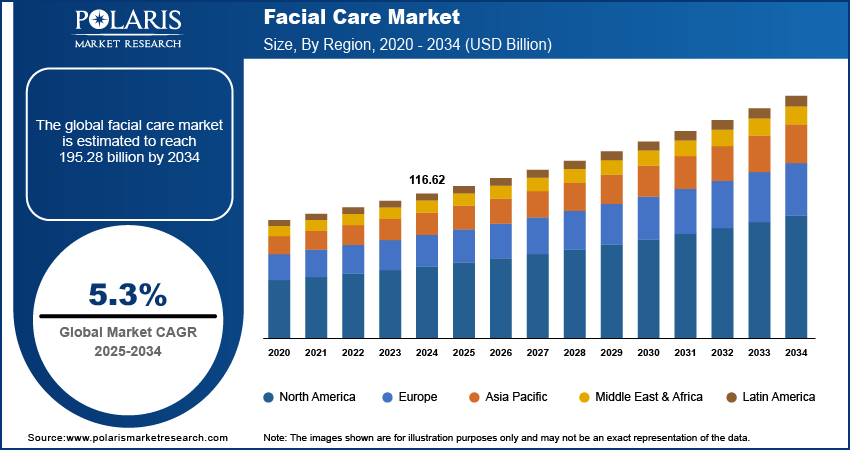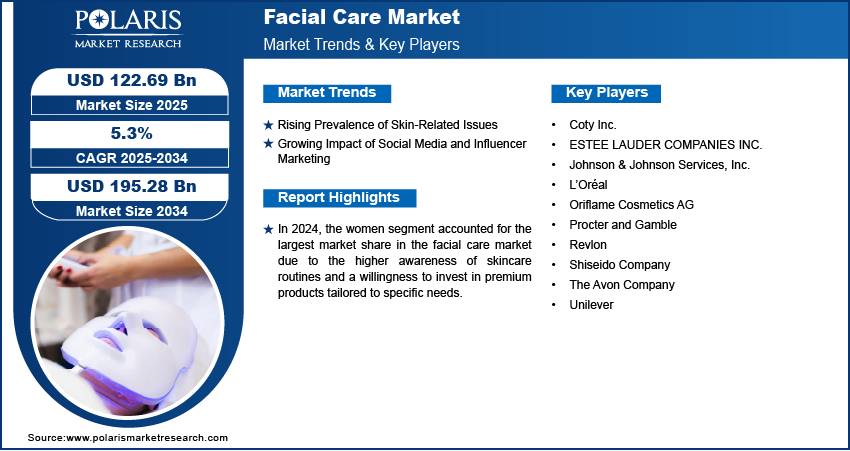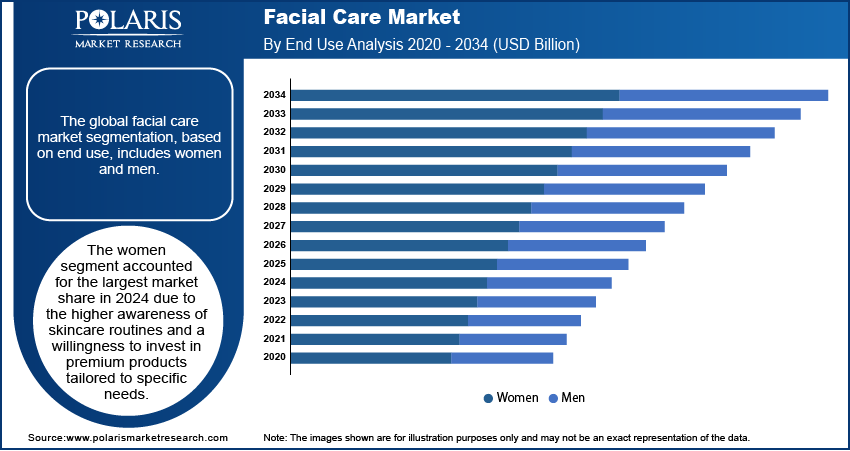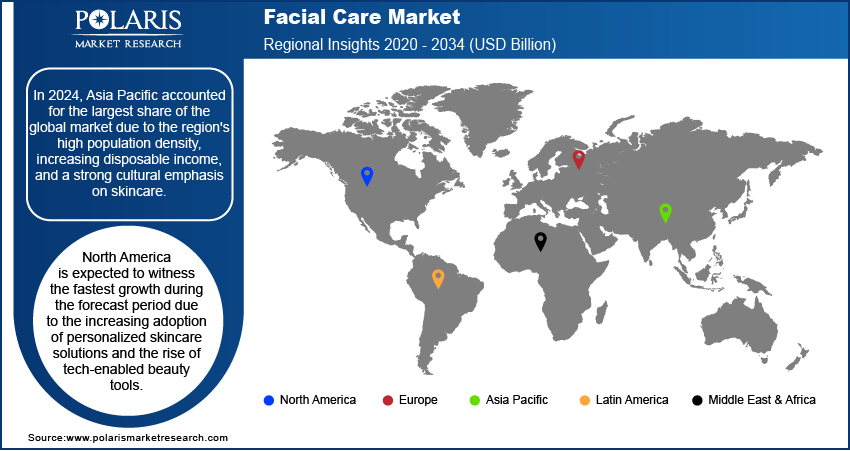
Facial Care Market Size, Share, Trends, Industry Analysis Report: By Product, End User (Women and Men), Distribution Channel, and Region (North America, Europe, Asia Pacific, Latin America, and Middle East & Africa) – Market Forecast, 2025–2034
- Published Date:Apr-2025
- Pages: 129
- Format: PDF
- Report ID: PM5489
- Base Year: 2024
- Historical Data: 2020-2023
Facial Care Market Overview
The global facial care market size was valued at USD 116.62 billion in 2024. The market is expected to grow from USD 122.69 billion in 2025 to USD 195.28 billion by 2034, exhibiting a CAGR of 5.3% from 2025 to 2034.
The facial care market includes a wide range of products and treatments designed to improve and maintain the health, appearance, and hygiene of facial skin. This market encompasses skincare products such as cleansers, moisturizers, serums, and masks, as well as professional services like facials and dermatological treatments.
The facial care market is witnessing significant growth due to rising consumer awareness about skincare and personal grooming. Consumers are increasingly prioritizing healthy skin, leading to a surge in demand for advanced facial care products such as anti-aging creams, serums, and facial masks. The shift toward natural and organic skincare solutions, free from harsh chemicals, is further driving market expansion. Eco-conscious consumers prefer plant-based ingredients, prompting brands to innovate with sustainable and cruelty-free formulations. Additionally, social media influence, beauty trends, and celebrity endorsements are accelerating product adoption. The facial care industry is poised for continuous growth with an increasing number of individuals seeking high-performance skincare solutions, driven by evolving consumer preferences and technological advancements in skincare formulations.

To Understand More About this Research: Request a Free Sample Report
The facial care market is experiencing significant growth due to advancements in skincare technology, particularly in anti-aging and dermaceutical products. These innovations cater to the increasing consumer demand for effective solutions that combat signs of aging, improve skin texture, and enhance overall appearance. Cutting-edge formulations with ingredients like peptides, hyaluronic acid, and retinol are gaining popularity, further propelling market expansion. Additionally, the rapid growth of e-commerce platforms has revolutionized the skincare industry by offering easy accessibility to a wide range of facial care products. Consumers worldwide can now conveniently purchase high-quality skincare solutions, compare products, and read reviews, driving market penetration. This digital transformation, combined with scientific breakthroughs in skincare, continues to fuel the growth of the global facial care industry.
Facial Care Market Dynamics
Rising Prevalence of Skin-Related Issues
The rising prevalence of skin-related issues, such as acne, pigmentation, and sensitivity, is significantly boosting the demand for targeted facial care treatments. For instance, according to the American Academy of Dermatology Association, acne is the most prevalent skin condition in the US, affecting about 50 million people annually. Approximately 85% of adolescents and young adults (ages 12 to 24) experience at least mild acne during this developmental stage. Consumers are increasingly seeking solutions tailored to address specific concerns, which has led to the development of advanced products such as anti-acne serums, brightening creams, and corrective skincare formulations. This trend is further fueled by heightened awareness of skin health and the availability of expert-driven, dermatologically-tested products. As a result, the facial care market is expanding, with brands innovating to cater to diverse skin types and conditions, meeting the growing demand for specialized treatments.
Growing Impact of Social Media and Influencer Marketing
Social media and influencer marketing are playing a pivotal role in shaping consumer preferences and driving the facial care market demand. For instance, a Pew Research Center survey highlighted YouTube as the leading online platform, with 83% of US adults reporting usage. Facebook follows closely, with 68% of Americans using the platform, highlighting the significant role these platforms play in digital engagement. Platforms like Instagram, TikTok, and YouTube allow influencers to showcase skincare routines, product reviews, and before-and-after transformations, creating a direct impact on purchasing decisions. These strategies enhance market growth by increasing brand visibility and consumer engagement. Additionally, social media allows brands to connect with a wider audience, driving market expansion across demographics and regions. The interactive nature of these platforms fosters trust and loyalty, encouraging consumers to explore and adopt new facial care products recommended by influencers.

Facial Care Market Segment Insights
Facial Care Market Assessment by Product Outlook
The global facial care market segmentation, based on product, includes lotion, face creams & moisturizers; cleansers & face wash; facial serums; face sheet masks; sunscreen/sun care, and others. In 2024, the lotion, face creams & moisturizers segment accounted for the largest market share due to its essential role in daily skincare routines and its ability to address a wide range of skin concerns, from hydration to anti-aging. This category benefits from continuous innovation, including advanced formulations enriched with hyaluronic acid, ceramides, and peptides, targeting specific consumer needs like long-lasting hydration and skin barrier repair. Additionally, the growing demand for multifunctional products, such as those combining sun protection, anti-pollution, and moisturizing properties, contributes to the segment’s dominance. Increasing consumer preference for lightweight, non-greasy textures and dermatologist-backed solutions has also solidified the segment's leading position in the market.
Facial Care Market Evaluation by End Use Outlook
The global facial care market segmentation, based on end use, includes women and men. The women segment accounted for the largest market share in 2024 due to the higher awareness of skincare routines and a willingness to invest in premium products tailored to specific needs. Women’s growing focus on anti-aging, pigmentation, and overall skin health has spurred demand for targeted solutions, including serums, creams, and specialized treatments. Furthermore, rising disposable income among women, coupled with access to global brands via e-commerce platforms, has significantly influenced purchasing patterns. Social media and beauty influencers have also played a critical role in educating women about product benefits and promoting skincare regimes, further reinforcing this segment’s dominance in the market.

Facial Care Market Regional Analysis
By region, the study provides the facial care market insights into North America, Europe, Asia Pacific, Latin America, and the Middle East & Africa. Asia Pacific accounted for the largest market share in 2024 due to the region's high population density, increasing disposable income, and a strong cultural emphasis on skincare. Countries like China, Japan, and South Korea led the market with advanced skincare innovations and the widespread popularity of beauty treatments like K-beauty and J-beauty. The demand for natural and organic skincare products is particularly strong in this region, driven by consumer preferences for clean and sustainable ingredients. Additionally, aggressive marketing by domestic and international brands, coupled with a booming e-commerce landscape, has facilitated accessibility to premium products, further strengthening the region's leading market position.
The North America facial care market is expected to witness the fastest growth during the forecast period due to the increasing adoption of personalized skincare solutions and the rise of tech-enabled beauty tools. Consumer demand for clean beauty products, free from harmful chemicals, is driving innovation within the market. Additionally, heightened awareness of skincare’s role in overall health, driven by dermatological education and targeted advertising, is fueling product adoption. The expansion of male grooming trends and the growing popularity of clinical-grade facial care solutions are also contributing to this growth. Retail channels, particularly e-commerce, are enhancing accessibility and driving market expansion. For instance, the Census Bureau reports that US retail e-commerce sales rose by 7.5 percent in Q3 2024 compared to Q3 2023, while total retail sales increased by 2.0 percent. E-commerce accounted for 15.6 percent of total sales during this period. These factors collectively contribute to the region’s robust growth in the global market.

Facial Care Market – Key Players and Competitive Insights
The competitive landscape of the facial care market is characterized by intense rivalry among global and regional players, driven by innovation, branding, and expanding consumer demands. Leading companies such as L'Oréal, Unilever, Estée Lauder, and Procter & Gamble continue to dominate the market through diverse product portfolios, investments in R&D, and strategic acquisitions to strengthen their presence. Emerging brands, particularly those offering clean, organic, and vegan skincare solutions, are disrupting the market by appealing to eco-conscious consumers. The rapid rise of direct-to-consumer (DTC) models and the use of artificial intelligence for personalized skincare has further intensified competition. In addition, regional brands in Asia Pacific, such as Shiseido and Amorepacific, leverage deep cultural knowledge and innovative formulations to maintain strong market positions. E-commerce platforms, coupled with influencer marketing, have created opportunities for smaller players to compete effectively, particularly in niche categories. Companies are also focusing on sustainability initiatives, such as recyclable packaging and ethically sourced ingredients, to differentiate themselves in a highly competitive and evolving market landscape.
Unilever PLC is a global consumer goods company with operations in the Asia Pacific, Africa, the Americas, and Europe. The company is structured into five main segments: Personal Care, Beauty & Wellbeing, Home Care, Nutrition, and Ice Cream. The Beauty & Wellbeing segment offers skincare solutions, hair care products, and premium beauty items, along with vitamins and dietary supplements. The Personal Care segment includes deodorants, soaps, and oral care products. Moreover, in Home Care, the focus is on fabric care items such as detergents and hygiene products. The Nutrition segment provides dressings, cooking aids, plant-based meat alternatives, beverages, and functional nutrition products. The Ice Cream segment features a variety of ice cream products for home and away-from-home consumption. Unilever’s extensive brand portfolio includes AXE, Ben & Jerry's, Dove, Hellmann's, Knorr, Magnum, and Vaseline, among others. Founded in 1860 and headquartered in London, UK, Unilever continues to provide diverse consumer needs globally. Unilever PLC offers facial care products under brands like Pond’s, Dove, Vaseline, and Simple, focusing on hydration, anti-aging, and skin nourishment.
L'Oréal S.A. is a French multinational personal care company specializing in the production and sale of beauty and hair products. Established in 1909 in Clichy, Hauts-de-Seine, France, the company has grown into the world’s largest beauty manufacturer. L'Oréal offers a wide range of products, including makeup, fragrances, hair care, sun care, skincare, and coloring products. The company operates through four segments, namely professional products, consumer products, l'oréal luxe, and active cosmetics. In September 2023, L’Oréal Groupe agreed to make a minority investment in Shinehigh Innovation, a biotech company based in China, to establish a long-term partnership aimed at jointly developing innovative and environmentally sustainable beauty solutions. L'Oréal S.A. offers facial care products including anti-aging creams, moisturizers, serums, cleansers, sunscreens, masks, and dermaceutical solutions globally.
List of Key Companies in Facial Care Market
- Coty Inc.
- ESTEE LAUDER COMPANIES INC.
- Johnson & Johnson Services, Inc.
- L’Oréal
- Oriflame Cosmetics AG
- Procter and Gamble
- Revlon
- Shiseido Company
- The Avon Company
- Unilever
Facial Care Industry Developments
In January 2025, Hindustan Unilever Limited (HUL) reached an agreement to acquire Minimalist, a premium actives-focused skincare brand. This acquisition supports HUL's strategy to enhance its Beauty & Wellbeing portfolio, targeting growth in evolving high-demand market segments.
In September 2024, Walgreens launched a new premium skincare line that combines high-quality formulations with affordability. This collection is designed to meet rigorous efficacy and safety standards, providing consumers access to effective skincare without a premium price tag.
In January 2024, Eucerin launched its Radiant Tone Collection, designed to target and reduce persistent hyperpigmentation through innovative formulations that promote an even skin tone.
Facial Care Market Segmentation
By Product Outlook (Revenue, USD Billion, 2020–2034)
- Lotion, Face Creams & Moisturizers
- Cleansers & Face Wash
- Facial Serums
- Face Sheet Masks
- Sunscreen/Sun Care
- Others (Scrub, etc.)
By End User Outlook (Revenue, USD Billion, 2020–2034)
- Women
- Men
By Distribution Channel Outlook (Revenue, USD Billion, 2020–2034)
- Supermarkets/ Hypermarkets
- Convenience Stores
- Pharmacy & Drugstore
- Online
- Others
By Regional Outlook (Revenue, USD Billion, 2020–2034)
- North America
- US
- Canada
- Europe
- Germany
- France
- UK
- Italy
- Spain
- Netherlands
- Russia
- Rest of Europe
- Asia Pacific
- China
- Japan
- India
- Malaysia
- South Korea
- Indonesia
- Australia
- Vietnam
- Rest of Asia Pacific
- Middle East & Africa
- Saudi Arabia
- UAE
- Israel
- South Africa
- Rest of Middle East & Africa
- Latin America
- Mexico
- Brazil
- Argentina
- Rest of Latin America
Facial Care Market Report Scope
|
Report Attributes |
Details |
|
Market Size Value in 2024 |
USD 116.62 billion |
|
Market Size Value in 2025 |
USD 122.69 billion |
|
Revenue Forecast by 2034 |
USD 195.28 billion |
|
CAGR |
5.3% from 2025 to 2034 |
|
Base Year |
2024 |
|
Historical Data |
2020–2023 |
|
Forecast Period |
2025–2034 |
|
Quantitative Units |
Revenue in USD billion and CAGR from 2025 to 2034 |
|
Report Coverage |
Revenue Forecast, Market Competitive Landscape, Growth Factors, and Trends |
|
Segments Covered |
|
|
Regional Scope |
|
|
Competitive Landscape |
|
|
Report Format |
|
|
Customization |
Report customization as per your requirements with respect to countries, regions, and segmentation. |
FAQ's
The global facial care market size was valued at USD 116.62 billion in 2024 and is projected to grow to USD 195.28 billion by 2034.
The global market is projected to register a CAGR of 5.3% during the forecast period.
In 2024, North America accounted for the largest market share due to its advanced healthcare infrastructure and significant investments in medical technology innovation.
Some of the key players in the market are Coty Inc.; ESTEE LAUDER COMPANIES INC.; Johnson & Johnson Services, Inc.; L’Oréal; Oriflame Cosmetics AG; Procter and Gamble; Revlon; Shiseido Company; The Avon Company; and Unilever.
In 2024, the lotion, face creams & moisturizers segment accounted for the largest market share due to its essential role in daily skincare routines and its ability to address a wide range of skin concerns, from hydration to anti-aging.
In 2024, the women segment accounted for the largest market share due to the higher awareness of skincare routines and a willingness to invest in premium products tailored to specific needs.
